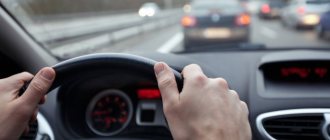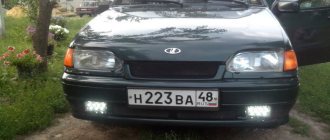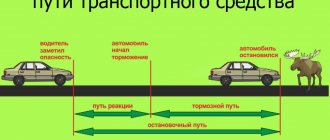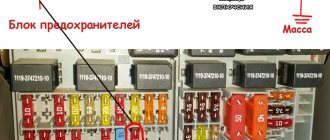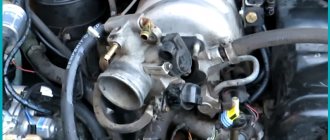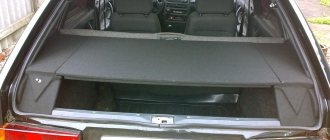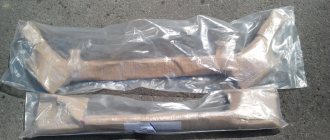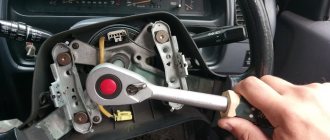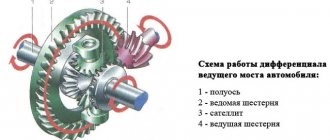Free program for calculating speed and braking distance
How to determine car speed and braking distance?
Below we consider a small free program for calculating the braking distance of a car at a known speed and vice versa (you can calculate the speed at a known braking distance).
Braking distance is the distance covered by a vehicle from the moment the braking device is activated until it comes to a complete stop.
The complete braking distance also includes the distance covered during the time from the moment the driver (driver) perceives the need to brake until the brake controls are activated.
The braking distance is proportional to the square of the driving speed, the speed at which the brakes are applied, the load on the braked wheels, the coefficient of adhesion between the wheels and the road, and also depends on the driver’s reaction. The length of the braking distance depends on the condition of the braking system, the speed of the vehicle, the condition of the road, as well as the condition and quality of the tires. When the vehicle speed increases, for example by 2 times, the braking distance increases approximately 4 times. On a wet road, the braking distance of a passenger car increases by 2 times compared to a dry road, and on a snowy and icy road surface - by approximately 4 times. The stopping distance includes the braking distance, as well as the distance that the car travels during the driver’s reaction time (from awareness of the danger to the start of pressing the brake pedal). The segment of the path covered by the car during the driver's reaction time, the car moves at a constant speed.
How to determine the speed of a car based on the braking distance?
Equally slow motion: v x v/2=Sa,
where v is the speed before braking begins,
S - distance traveled (the length of the black trace of rubber smeared on the asphalt),
a - acceleration (deceleration) during braking.
This is taken from the transition of ALL kinetic energy into the work of friction (rubber destruction, i.e. black mark). The adhesion coefficient value can be from 0.7-0.9 for dry asphalt and good tires to 0.03-0.01 on ice. Skillful braking on the verge of wheel blocking (good ABS operation) can increase the friction coefficient by 10-20 percent, but this is not our case: since there is a black mark on the asphalt, the wheels were blocked. The minimum permissible brake efficiency for a passenger car is 0.64 (for every ton of weight, the braking force is 640 kg) is regulated in GOST 25478-91 for brakes in general. It is assumed that on dry asphalt (or on the rubber of the drum on the PIK) the grip of the rubber is much better, so this is the quality of the brakes themselves. The stopping distance also includes the distance covered at the initial speed during the driver’s reaction time (0.2 sec) and the braking system response time (according to GOST 25478-91, no worse than 0.5 sec for passenger cars). There is no black mark left on the asphalt at this time, and in speed calculations, only the braking distance is used from the length of the braking mark.
The speed along the braking distance recorded in the protocol will be determined by the traffic police : they have a handwritten diagram, where the corresponding speed is set opposite a certain length of the braking distance; Plus or minus is not a big deal for them.
Calculation of braking distance and speed
The examination of the State Traffic Safety Inspectorate and the Ministry of Internal Affairs uses the following formulas and methods. You can find and do the calculations yourself.
Va =0.5 x t3 x j + v2Syu x j = 0.5 0.3 5 + v2 x 21 x 5 = 0.75 +14.49 = 15.24 m/s = 54.9 km/h
where: in the expression v2Syu x j, v is the square root of the entire expression, it just didn’t work out when writing. Va is the initial speed of the car, m/s; t3 — vehicle deceleration rise time, s; j is the steady deceleration of the vehicle during braking, m/s2; (for wet pavement - 5 m/s2 according to GOST 25478-91 or the appendix below) for dry pavement j = 6.8 m/s2, hence the initial speed of the car at a skid of 21 m is 17.92 m/s, or 64.5 km /h; Syu - length of the brake track (skid), m.
T0 = t1 + t2 + t3 + t4 = T + Va / j; By taking T = t1 + t2 + 0.5 t3, you can easily calculate the stopping distance and stopping time of the car. This can be calculated to compare the driving conditions of two participants in an accident.
Braking distance S=Kе*V*V/(254*Фс) , where Ke is the braking coefficient (for a passenger car = 1); V — speed in km/h at the beginning of braking; Fc - road adhesion coefficient (=0.7 dry asphalt, 0.4 wet road, 0.2 compacted snow, 0.1 icy road).
Skid trail
In expert practice, it is generally accepted that skid marks caused by wheel locking remain only during the period of full braking (i.e., full braking), and the moment the marks begin to form coincides with the moment of steady-state deceleration, hence: Syu=Vyu*Vyu/2j , where Syu is the length of the braking trace (m); Vу - vehicle speed at the beginning of full braking (m/s) j - steady deceleration of the vehicle with full use of traction by all vehicle tires (m/(s*s))
Definitions and formulas
Stopping path
Traffic rules 10.1 - safe driving speed
The stopping distance is the distance a car travels from the moment the driver sees the danger, assesses it, decides to stop and presses the brake pedal until the car comes to a complete stop. This distance is the sum of several distances that the car travels while the driver makes a decision, the brake system mechanisms are activated and the movement slows down to a complete stop.
where s
hr is the distance that the car will travel during the driver’s perception and assessment of the situation, s
hr is the distance the car will travel during the driver's reaction to the situation,
s
brl is the distance the car will travel during the brake delay, and
s
br is the braking distance.
The distance that the car will travel while the driver perceives and assesses the situation
Human perception distance is the distance a car will travel while the driver assesses the danger and decides to slow down and stop. It is determined by the formula
where s
hp distance of human perception in meters, v
car speed in km/h,
t
hp is the human perception time in seconds and 1000/3600 is the conversion factor from kilometers per hour to meters per second (1 kilometer is equal to 1000 meters and 1 hour is equal to 3600 seconds).
The distance the car will travel during the driver's reaction
Driver reaction distance is the distance the vehicle will travel while the driver executes the decision to stop the vehicle after assessing the hazard and making the decision to stop. It is determined by the formula
where s
hp — driver reaction distance in meters, v
— vehicle speed in km/h and
t
hr — driver reaction time in seconds.
The distance the vehicle will travel when the brake system is applied
The distance that the vehicle will travel when the brake system is applied depends on the type of braking system installed on the vehicle. Almost all cars and light trucks use a hydraulic braking system. Most heavy-duty vehicles use air-actuated brakes. The response delay for pneumatic brakes is approximately 0.4 s, and for hydraulic brakes (the fluid is incompressible!) 0.1–0.2 s. Total brake response lag is measured as the time from the moment the brake pedal is pressed until deceleration becomes steady. It consists of a delay in the response of the braking system and the time for establishing a constant deceleration value. In an air brake system, the air takes time to travel through the brake lines. On the other hand, a hydraulic drive has virtually no lag and operates two to five times faster than a pneumatic drive.
The distance that the car will travel when the brake system is activated is determined by the formula
where s
brl is the distance in meters that the car will travel when the brake system is activated, v
— vehicle speed in km/h,
t
brl — braking system response time in seconds.
Slowdown
To simplify the calculations, let us assume that the car is moving with constant acceleration or deceleration, which is determined by the formula of uniformly accelerated or uniformly decelerated motion known from the course of elementary physics
where a
— acceleration, v
is the initial speed,
v
is the final speed and
t
is time.
Car braking distance
The braking distance of a car is the distance the car travels from the moment you fully press the brake pedal until it comes to a complete stop. This distance depends on the speed of the vehicle before braking begins and on the coefficient of friction between the tires and the road surface. In this calculator we do not take into account other factors that affect braking distance, such as tire rolling resistance or air drag
P O P U L A R N O E:
CMS X-FS Free - This is a free system for managing your website.
For those who want to create their first website for free.
This system is designed to quickly and easily create a website for beginners! Suitable for developing both personal websites and creating a business card website about a company or organization. Thanks to detailed instructions and tips, even the most untrained user can handle installation and operation.
Today there is a wide variety of imported equipment on the market. Without knowledge of a foreign language, carry out repairs, adjustments, etc. imported equipment is more difficult than knowing, for example, English. Schemes and instructions, if translated, are not always correct.
Learning a foreign language includes several aspects, one of which is knowledge of vocabulary (words) and grammar. Possession of a good vocabulary compensates for your lack of knowledge of some features of the language. Therefore, the main thing when learning any foreign language is memorizing words!
In my 2003 Toyota Corolla, only cassette car radios were installed by the manufacturer. Of course, I didn’t listen to cassettes at all, and had to make do with only an FM receiver.
Source
How to calculate the speed of a car based on the braking distance
How to determine the speed of a car based on the braking distance
One of the main factors influencing the investigation of the circumstances of an accident is determining the distance that the car traveled before braking. Knowing the braking distance, you can calculate the ground speed an instant before the collision.
How to calculate the braking distance of a car.
Most car owners probably know how quickly a car accelerates. Even if you haven’t measured the acceleration dynamics of your car, you’ve probably looked at the factory specifications of your car, where the automaker usually indicates the minimum possible acceleration time from 0-100 km/h. But now the question is: how long does it take to stop your car? Do you know this? We are sure not. But it turns out that you can calculate the braking distance quite easily using a simple formula. We'll tell you how it's done.
Formulas for calculating speed along braking distance
After a traffic accident, the actual braking distance of the car is measured by traffic police officers or an investigator by recording the tire tracks on the asphalt and entering the data into a special calculation table. Several factors are taken into account:
First of all, you need to quickly establish the speed at which the car was moving before braking. It is calculated as follows
The acceleration of free fall is a physical constant and does not change, no matter in what formula its value is used. The speed from km/h must be converted to m/s, in the ratio 36 to 10: 36 km/h = 10 m/s. According to GOST 25478-91, the permissible minimum efficiency of the vehicle braking system is 0.64. This means that per ton of vehicle weight there must be a braking force of at least 640 kg.
The main factor influencing the accuracy of the calculation
The only variable in the speed formula is the braking distance. Manual calculation of this value under ideal conditions (driving at a speed of 60 km/h on a dry asphalt road, braking without skidding) can be done using the formula
v – vehicle speed at the beginning of braking, m/s;
μ – friction coefficient;
g – free fall acceleration, m/s2.
Another formula to check the correctness of the initial calculation
Ke – the value of the braking coefficient;
V – speed at the moment of braking;
Фс – the value of the coefficient of adhesion of tires to the road surface (in dry weather - 0.7, in rainy weather - 0.4; in snow - 0.2; in ice - 0.1).
So, when driving on a dry asphalt road at a speed of 60 km/h, the braking distance will be S = 1*60*60/(254*0.7) = 20.25 m. When driving on an icy road, on which Fs drops from 0.7 to 0.1, the value of S will increase 7 times (141.7 m).
Thus, the main task for correctly calculating speed is determining the stopping distance. Its composition, in addition to the braking distance itself, includes footage pertaining to:
Braking distance of a car at a speed of 60 mph
Body deformation in a collision at a speed of 60 km/h
Stopping distance
also depends not only on the driver, but also on other related factors: the quality of the road, driving speed, weather conditions, the condition of the brake system, the design of the brake system, vehicle tires and many others.
Please note that the weight of the car does not affect the braking distance. This is due to the fact that the weight of the car increases the inertia of the car when braking, thereby preventing braking, but increases the grip of the tires on the road due to the increased weight of the car. These physical properties compensate each other, while having virtually no effect on the braking distance.
These physical properties compensate each other, while having virtually no effect on the braking distance.
The braking speed directly depends on the braking method. Hard brake
all the way, will lead to the car skidding or skidding (if the car is not equipped with an ABS system).
The pedal is used when there is good visibility and a calm environment on the road; it is not suitable for emergency situations. When pressed intermittently
You can lose control, but you can stop quickly. Stepwise pressing is also possible
(similar in effect to the ABS system).
Braking distance on dry asphalt
Let's remember physics lessons, where ?
is the friction coefficient, g
is the acceleration of free fall, and v
– vehicle speed in meters per second.
The situation is as follows: a driver is driving a Lada car whose speed is 60 km/h. Literally 70 meters away is an elderly woman, who, forgetting about safety rules, hastily catches up with a minibus (a standard situation for Russia).
The result obtained from the formula is 20.25 meters. Naturally, this value is appropriate only for ideal conditions, when the car is equipped with high-quality tires and brake pads, the brake system is working properly, and when braking you do not skid or lose control, due to many other idealized factors that do not occur in nature.
Also, to double-check the result, there is another formula for determining the braking distance
We substitute the vehicle speed in km/h.
It turns out that the braking distance is 20 meters for a speed of 60 km/h (for ideal conditions), if the braking is sharp and without skidding.
Calculation of speed during examination
To expertly determine the initial speed of a machine, specialists use the formula:
Va = 0.5*tз*j + √2Sь*j,
tз – time during which the vehicle speed slows down, s;
j – deceleration constant at the moment of braking, m/s2 (determined by reference, based on GOST 25478-91);
Sу – length of the trail during braking, m.
On a dry road, j is equal to 6.8 m/s2, so the skidding speed of a car braking at a distance of 21 meters is 64.5 km/h.
After the driver begins to react to the environment, the car goes through the so-called stopping distance until the speed is completely zeroed.
So = (S1 + S2 + S3 + S4) = (t1 + t2 + 0.5*t3)*Va + Va/2j,
t1 – driver reaction;
t2 – delay of the hydraulic drive of the brake system;
tз – increase in deceleration.
The time interval t4 (full stop time) is calculated as the ratio of the skidding speed Vу to the deceleration j. The time until the deceleration rate increases depends on three indicators:
To determine it, half should be subtracted from the initial speed Va until the minimum speed tз*j is established. Thus, the total time of the dynamic part of an accident for a car is t0 = t1 + t2 + t3 + t4 = T + Va/j, s.
Attention! The deceleration increase time for a pneumatic drive is longer than for a hydraulic drive. It increases with the curb weight of the vehicle and the coefficient of adhesion.
This cannot be avoided when performing calculations.
Another important indicator is the length of the skid when braking. This is the ratio of the square of the skid speed to twice the deceleration constant j. The car wheels blocked by chocks begin to leave such a mark on the road surface when the pedal is in the “pedal to the floor” position. The beginning of the trace is the point of steady deceleration, that is, constant. As mentioned above, this is an experimental value. It is calculated for each type of transport separately. In this case, the physical formula is used
The longitudinal adhesion of rubber to the road surface f is measured empirically, using a “fifth wheel” or special devices.
To simplify the perception of the mathematical calculations being made, we will link the stopping distance to the speed of a car 4 m long. The link is made to a speed of 64 km/h, with a step of ½ in the direction of its slowdown and increase:
The way to the driver's reaction,
The distance from the start of braking to the stop,
Source
Determining the speed of the car based on the obtained deformations
Only a very small number of experts determine the speed of a car in this way. Although the dependence of car damage on its speed is obvious, there is no single effective, accurate and reproducible method for determining speed from the resulting deformations. This is due to the huge number of factors influencing the formation of damage, as well as the fact that some factors simply cannot be taken into account. The formation of deformations can be influenced by:
Determination of speed at the moment of impact (collision)
The speed at the time of a collision is usually determined by the braking mark, but if this is not possible for a number of reasons, then approximate speed figures can be obtained by analyzing the injuries sustained by a pedestrian and the damage caused by a collision with a vehicle.
For example, the speed of a car can be judged by the characteristics of a bumper fracture - a trauma specific to being hit by a car, which is characterized by the presence of a transverse fragmentation fracture with a large fragment of bone of an irregular diamond shape on the side of the impact. Localization when hit by a bumper of a car is the upper or middle third of the lower leg, for a truck - in the thigh area.
The question of determining the speed of a vehicle immediately before a collision, collision with a pedestrian or a stationary object is one of the most pressing in expert practice. Firstly, speeding is the most common traffic violation. Secondly, speed affects the driver’s ability to stop his car in time, narrows the driver’s viewing angle, reduces his attention to the situation on the road, and also affects other important factors.
In theory, there are three main ways to determine speed, and in some situations it would be possible to use all methods.
First way.
Determination of speed by the length of braking and sliding marks recorded at the scene of the incident. This method is the most applicable in expert practice, because Many scientific works and methodological manuals have been compiled with the formulas and coefficients given in them for such calculations. Its advantage is the simplicity of calculation, and therefore the speed of carrying out such research. But it has a number of significant disadvantages. Firstly, this calculation is carried out taking into account the length of the skid marks left behind. If they are not visible or not recorded, the vehicle was not braked, then it will not be possible to determine the speed in this way. Secondly, this method does not take into account the influence of the action of one vehicle on the movement of another. For example, a car left braking marks 5 m long, and then collided with another vehicle, moving it another 10 m. In this calculation, only the length of the marks - 5 m - will be taken into account, and accordingly the speed according to this calculation will be very low. Undoubtedly, in order to move another vehicle over a distance of 10 m, one must have a large amount of movement, and therefore speed, this is especially noticeable when the moved vehicle turns out to be of greater mass. To take these parameters into account, the second method is used, described below. Thirdly, this method does not take into account the expenditure of kinetic energy on the formation of damage to the vehicle, because in a collision the speed can be significantly reduced by deformation of the structure of both vehicles.
Second way.
Determination of speed from the law of conservation of momentum. It is thanks to this law, studied in physics lessons in high schools, that it is possible to determine the speed of a car, taking into account its movement after an accident, as well as the movement of another car made under the influence of the first car. This method is used in conjunction with the 1st method in the case of signs of braking; if they are absent at the scene of the incident, it is used independently. The use of this method is especially convenient in case of cross collisions made at an angle close to a straight line, as well as in the event that one of their vehicles is stationary immediately before the collision. Let us give an example when the use of this method is obvious. Car No. 1 started moving when the traffic light turned green. Car No. 2, whose driver intended to make it through the intersection in time for the prohibitory traffic light, was moving in a transverse direction from left to right in relation to the 1st car. As a result of the collision, the 1st car shifted several meters to the right, relative to the direction of its movement. It is absolutely obvious that this displacement occurred under the influence of an impact from the 2nd car. Knowing the direction of their movement, the angle of interaction, the distance of movement after the collision, as well as the speed of the 1st vehicle, you can set the speed of the 2nd vehicle. As you can see, the use of this method is justified if all the listed information is available or if it is possible to establish it by expert means. Its disadvantage is the error, since this method uses several data; inaccurate determination of at least one leads to an inaccurate result. Also, for this method, it is necessary to know the mode of movement of vehicles after the collision, whether they were braked, whether the tires were sliding on the asphalt, or whether the car was in free rolling - all this plays a role in the calculations. Sometimes the mode of movement of the vehicle is obvious, but often it cannot be established, which means that in the calculation the expert can use several values and formulate an alternative conclusion. This method, like the 1st one, does not take into account the energy costs for the formation of deformations. Despite the obviousness of this method of determining speed, it is not always used in expert practice. The reasons for this are unknown to us, perhaps this is due to more complex calculations compared to the first method.
Third way.
Determination of speed based on the obtained deformations. This method is the most controversial and is not widely used; we can say that only a few experts use it. Despite the obviousness of the fact that the higher the speed of the car, the more serious damage it can receive, at the moment there are no sufficiently substantiated and proven methods for solving this problem. Those few experts who determine the speed of a car by deformations issue conclusions with very accurate conclusions, setting the speed of movement to tenths. Such accuracy is very doubtful, because a huge number of factors influence the speed of a car, and even more influence the formation of damage. Loss of speed during braking and collision depends on the tires (tire pressure, degree of wear, tread pattern, presence of studs), the presence and type of anti-lock braking system, effective braking system, condition of the brake pads, vehicle design, its service life, streamlining, load, etc. including load distribution, friction coefficient in a particular area, as well as many other factors, including wind strength and direction. Almost all of these factors are not taken into account when making these calculations, and taking some of them into account is practically impossible. Because of this, it would be more convincing if, even taking into account the use of speed calculation methods that are not approved or tested, these experts pointed out the inaccuracy of this method and the presence of some error. An important factor is that to determine the speed using this method, it is necessary to have information on the design of the car of each brand, model and modification; this information is not disclosed by manufacturers. Moreover, over time, the metal ages and reacts to loads in a different way, not to mention the fact that the car could have undergone restoration repairs, which means that the properties of the structures have undergone some changes. As you can see, for an objective, complete and justified calculation using this method, a huge amount of data is needed, most of which currently remains inaccessible. As a result, this method is practically not used in the examination of road accidents. However, citizens applying for an automotive technical examination most often believe that the speed of vehicles is determined in this way.
Automotive experts of the ANO "Forensic Expertise" use the first and second methods when establishing the speed of a vehicle; the third method is not used due to its insufficient validity at present.
Empirical formula for calculating braking distance
Having an excellent driver's eye and sufficient experience, everyone will be able to determine the distance to an object by eye, at least approximately. Driving experience shows that to instantly calculate the braking distance by speed, you just need to glance at the speedometer, estimate the distance to the obstacle, then the braking distance will be equal to half the number that the speedometer shows. That is, based on the empirical formula for calculating the braking distance, the safe distance to any object will be equal to the instantaneous speed, divided in half. In almost the same way, they calculate the speed of a car along the braking distance.
In this case, it is necessary to take into account such a concept as stopping distance, this is the term of traffic police experts and it takes into account not only the braking distance itself, but also the reaction speed, as well as the reaction time of the brake system. In principle, this is the distance to the absolute stop of the car from the moment when the driver detected the obstacle. Naturally, the stopping distance is always longer than the braking distance, since the average reaction speed of a healthy and sober driver is about 0.8 s, and the braking system is activated in another 0.2-0.3 s. Therefore, another 1.1 s will pass before the car comes to a complete stop, and at a speed of 60 km/h the car travels 16.6 meters in one second. Almost seventeen meters, which will inevitably be added to the length of the braking distance and which is rarely taken into account by most drivers. This is precisely why it is necessary to take at least a theoretical calculation of the braking distance seriously.
Car braking distance
Let us remind car enthusiasts of some important facts about the braking distance of a car, what affects it and how to really reduce these meters, which are so important for everyone.
Braking distance, stopping distance - what's the difference?
The distance within which the car will come to a complete stop, starting from pressing (pressing) the brake pedal (handle), is the braking distance. There is no human factor or reaction time here - these are purely technical characteristics. According to the Ukrainian traffic regulations, you cannot operate a car with travel indicators above the norm.
Table of maximum allowed indicators:
| Transport | Braking distance, m |
| Passenger car | 14,7 |
| Bus | 18,3 |
| Truck with a weight of up to 12 tons | 18,3 |
| Trucks with a maximum permissible weight over 12 tons | 19,5 |
| Motorcycles and mopeds | 7,5 |
At the same time, the following speed value was taken: for cars and buses - 40, for motorcycles - 30 kilometers per hour.
If the vehicle is traveling at a speed higher than the specified speed, the distance required to stop becomes much longer.
Stopping path
This is the distance that the vehicle will travel from the moment the driver detects an emergency until the car stops. That is, this is the sum of the braking distance and the distance traveled by the car while the person was reacting to the danger.
Impact force
Using the laws of physics and the effects of forces on moving objects, you can easily determine the force of a car hitting an obstacle. For clarity, experts compare the impact with a fall from a height:
| Speed, km/h | Fall height, m |
| 35 | 5 |
| 55 | 12 (3-4 floor) |
| 90 | 30 (9th floor) |
Now you can understand that in a collision even at low speed you can get serious injuries. Therefore, you must do everything possible to prevent a collision - go around an obstacle or brake urgently.
What determines the vehicle stopping distance?
The braking distance of a car can be affected by:
- vehicle load;
- rubber, its condition and quality (for example, with studs, newly purchased, with worn tread), pressure in them;
- availability of security systems;
- weather and, as a result, road condition;
- road surface (for example, gravel, primer, asphalt, concrete);
- vehicle speed.
Travel speed
With a twofold increase in speed, the distance will be four (!) times longer, and if the car travels three times faster than usual, then it will be 9 times longer.
Road and weather
On smooth and dry asphalt the distance will be longer than on rough surfaces. And on wet asphalt, in icy conditions, in snow, any vehicle will not only be difficult to stop, but also skidding and loss of control by the driver is possible.
| Road | Tire grip on asphalt (average coefficient) |
| Dry | 0,7 |
| Wet | 0,4 |
| Snow | 0,2 |
| Ice | 0,1 |
Approximate calculations of the dependence of the car’s braking distance on the road condition and vehicle speed:
| Speed | Dry coating, m | Wet coverage, m | Snow, m | Ice, m |
| 60 | 20,2 | 35,4 | 70,8 | 141,7 |
| 70 | 27,5 | 48,2 | 96,4 | 192,9 |
| 80 | 35,9 | 62,9 | 125,9 | 251,9 |
| 90 | 45,5 | 79,7 | 159,4 | 318,8 |
Auto-Dor driving school specialists strongly recommend that beginners and inexperienced drivers not only adhere to the permitted speed, but also not be distracted by phones and tablets while driving. The braking distance depends on the car, but the reaction time directly depends on the driver’s constant monitoring of the road situation.
Security systems
Having ABS, EBD and other electrical systems is not always good. In bad weather, on low-quality roads, these systems, on the contrary, can “interfere” with the car and the driver in controlling it and lengthen the braking distance of the car.
Machine load
The more cargo a car carries, the longer its journey will be. In addition, if the load is distributed incorrectly under conditions of emergency reactions and emergency control, the vehicle may overturn, roll over, and skid.
How to reduce a car's braking distance
It is difficult to influence the technical process from a human perspective, but it is possible.
Regular check
The most important thing a driver can do to reduce the distance is to entrust a professional to check the technical condition of the car, and do this regularly. It is especially important to monitor the serviceability of all elements of the brake system. Worn-out pads and “bald” tread add deadly meters to the length of the path.
Safe speed
We have already talked about the meaning and influence of auto speed on the path above.
Safe distance
In order to have time to brake when dangerous situations arise, you should keep the correct distance. Experts indicate that at 60 kilometers per hour, the safe distance to the vehicle ahead is about 60 m. It is very sad that many drivers do not take this into account at all.
So, the braking distance of a car depends on many factors and indicators. The driver can only partially influence the length of the braking distance, but this should not be neglected. It is better to do everything possible to make the roads safe for everyone.
(1 5,00 out of 5)
(063) 881-28-26 (Viber - only for correspondence and exchange of documents)
Source: https://auto-dor.com.ua/tormoznoy-put-avtomobilya/
Driver reaction time and path
Driver reaction time is the time that will pass from the moment the driver detects a danger on the road until the start of taking measures to prevent it.
The driver's reaction path is the distance the vehicle will travel from the moment the driver detects a hazard on the road until the brake pedal is pressed.
Here is the formula for calculating the distance a car will travel when the driver reacts to danger:
(Speed in km/h: 10) x 3 = reaction distance in meters
Calculation example: imagine that you are driving at a speed of 100 km/h along a country road and suddenly an elk runs out onto the road. Calculation: (100 km/h: 10) x 3 = 30 (meters). That is, after you react to a danger on the road, your car will travel about 30 meters. Add to this the braking distance of the car.
Attention: these rules are not scientifically correct formulas and provide only approximate values!
Note to the driver: table of dependence of braking distance on speed d
We are all always in a hurry somewhere in our cars and very rarely keep our distance. And when we get into an accident, we realize that a couple of centimeters were missing. There are two opinions about the safe distance between moving cars:
- The distance should be equal to half the speed value. For example, at 80 km/h, this value should be 40 meters.
- The distance should be equal to the speed of the moving car.
The traffic rules state that the driver must determine the safe distance depending on the driving conditions. But how can we define it?
But first, some terms: Sost. - stopping distance from the moment an obstacle is detected to a complete stop; Sp - the distance traveled by the car from the moment an obstacle is detected until the brake pedal is pressed; Storm — the braking distance itself. Accordingly, Srest.=Sр+Sbr.
The Sp indicator varies depending on the driver’s age, gender, health, etc. In different states, we react at different speeds to the situation on the road.
Below is a table of the dependence of the braking distance on the speed of the vehicle, which is given by the website kolesanews.ru.
According to traffic regulations, the braking distance of a light car at a speed of 60 km/h should not exceed 12.2 meters.
Based on the values in the table, the opinion of the second group of experts, who believe that the distance between moving cars should be equal to the speed of the vehicle, seems more correct, or rather safer.
Below is a video featuring the Tavria car. The braking distance of the car from 100 km/h to a complete stop is 44 meters!
What is needed to calculate braking distance
To calculate the braking distance, the formula of which is indicated in the figure with explanations, it is not enough to know instantaneous dry data.
Theoretically, to evaluate the braking performance of a car, it is necessary to use a lot of data:
There are a number of points to consider here. For example, the effectiveness of the braking system in each car can be different and this goes without saying. The hydraulic brake system gives a delay of at least 0.2-03 s, and the pneumatic brakes installed on most trucks and buses are even longer, up to 0.6 s. In addition, there is such a thing as an increase in braking force from zero to a maximum value, and this also takes from 0.4 to 0.6 s, while the influence of speed on the braking distance in this case increases squared, that is, with increasing speed is doubled, the braking distance will be four times longer.
How to calculate the total stopping time and the final braking distance?
As we have already said, in order to calculate the entire braking distance, it is necessary to take into account the loss of time when the driver makes the decision to brake (that is, the driver’s reaction time). To do this, you need to use a different formula, which provides a more accurate approximate calculation of the braking distance that the car will travel at the moment the decision is made to stop. Here is the formula:
(Speed in km/h: 10) x 3 = reaction distance in meters
As a result, by making calculations using the above formulas, you can calculate the approximate final braking distance of your car at any speed. Here's an example. If you drive your car at a speed of 50 km/h, then using the given formulas calculate the following values:
How to increase the intensity of deceleration
From the above, it became clear what is called the braking distance and what this indicator depends on. However, is it possible to reduce the distance required to stop a car? Maybe! There are two ways to do this - behavioral and technical. Ideally, the driver combines both methods.
It should be remembered that reducing the time required to stop is one of the ways to ensure a safe trip. Therefore, every driver must constantly monitor the technical condition of his “iron horse”, promptly maintain and repair the braking system. In addition, it is important to choose the driving speed taking into account the surrounding situation: time of day, road condition, car model, etc.
What does the braking distance depend on and what formula can it be calculated by?
Braking distance is the distance it takes for a vehicle to come to a complete stop from the moment the braking system begins to operate.
In everyday life, this term is often confused with stopping distance, but braking distance and stopping distance are different concepts. In the latter case, the distance elapsed from the moment the driver realized the need to brake to a speed of 0 km/h is taken into account. The braking distance is part of the stopping distance.
What does braking distance depend on?
The indicator under consideration is not a constant value and can vary for a number of reasons. All factors influencing the braking distance can be divided into two large groups: driver-dependent and driver-independent. Reasons beyond the control of the person driving include:
- road condition;
- weather.
It is easy to guess that in rain, snow or ice, the distance required to stop a car will be greater than on dry asphalt. Braking will also take a long time when driving on smooth asphalt, to which stone chips have not been added. Here the wheels have nothing to catch on, unlike rough surfaces.
Note: it is worth noting that poor quality of the road (potholes, potholes) does not lead to an increase in the distance required to stop. The human factor plays a role here. Trying to save the suspension, drivers rarely reach high speeds on such roads. Accordingly, the braking distance here is minimal.
Factors depending on the driver or owner of the car:
- brake condition;
- system design;
- presence of ABS;
- type of tires;
- vehicle load;
- movement speed.
The fact that the length of a car’s braking distance directly depends on the serviceability of the braking system does not require proof. A car with a malfunctioning brake circuit or worn out pads will never be able to stop as quickly as a working vehicle.
A lot depends on the design of the brake units. Modern cars equipped with rear disc brakes and brake assist systems have much better traction and shorter braking times.
In turn, the presence of EBD with ABS does not always help reduce the distance required to stop. On dry hard surfaces, where wheel locking occurs only with very intense braking, the system actually shortens the braking distance. However, on bare ice, the “smart” electronic assistant begins to reduce braking force even when you lightly press the brake pedal. At the same time, the car retains controllability, but its braking distance increases significantly.
What determines the rate of deceleration? Of course, it depends on the type of tires. So, on bare, albeit frozen, asphalt, as well as in slushy snow, the so-called brakes are best. “Velcro” are winter tires that are not equipped with studs. In turn, in icy conditions and on snowy roads, studded tires are the most effective. An important factor influencing the size of the stopping distance is the speed and load of the machine.
It is clear that a lightweight car at a speed of 60 km/h will stop faster than a truck loaded to capacity and moving at a speed of 80-100 km/h. The latter will not be allowed to stop quickly by speed and inertia that is too high for him.
When and how measurements are taken
Braking distance calculations may be required in the following cases:
- technical testing of the vehicle;
- checking the capabilities of the car after modifying the brakes;
- forensic examination.
As a rule, the formula S=Ke*V*V/(254*Fs) is used in the calculation. Here S is the braking distance; Ke – braking coefficient; V₀ — speed at the start of braking; Фс – coefficient of adhesion to the coating.
The coefficient of road adhesion varies depending on the condition of the surface and is determined according to the following table:
State of the road Fs
| Dry | 0.7 |
| Wet | 0.4 |
| Snow | 0.2 |
| Ice | 0.1 |
The Ke coefficient is a static value and is unity for all the most common passenger vehicles.
Example: how to calculate the braking distance of a car when the speedometer shows 60 km/h in the rain? Given: speed 60 km/h, braking coefficient – 1, adhesion coefficient – 0.4. We count: 1*60*60/(254*0.4). As a result, we get the figure 35.4, which is the braking distance in meters.
The table shows how many meters the car will continue to move until it comes to a complete stop. It should be taken into account that no other indicators are taken into account (turns, potholes on the road, oncoming traffic, etc.). It is doubtful that in real conditions on an icy road, a car will be able to slide for a kilometer without encountering a pole or bump stop.
Speed Dry Rain Snow Ice km/h meters
| 60 | 20,2 | 35,4 | 70,8 | 141,7 |
| 70 | 27,5 | 48,2 | 96,4 | 192,9 |
| 80 | 35,9 | 62,9 | 125,9 | 251,9 |
| 90 | 45,5 | 79,7 | 159,4 | 318,8 |
| 100 | 56,2 | 98,4 | 196,8 | 393,7 |
| 110 | 68 | 119 | 238,1 | 476,3 |
| 120 | 80,9 | 141,7 | 283,4 | 566,9 |
| 130 | 95 | 166,3 | 332,6 | 665,3 |
| 140 | 110,2 | 192,9 | 385,8 | 771,6 |
| 150 | 126,5 | 221,4 | 442,9 | 885,8 |
| 160 | 143,9 | 251,9 | 503,9 | 1007,8 |
| 170 | 162,5 | 284,4 | 568,8 | 1137,7 |
| 180 | 182,2 | 318,8 | 637,7 | 1275,5 |
| 190 | 203 | 355,3 | 710,6 | 1421,2 |
| 200 | 224,9 | 393,7 | 787,4 | 1574,8 |
We found an interesting calculator that not only calculates the indicator depending on the speed and condition of the road, but also clearly shows the whole process. Located here.
How to increase the intensity of deceleration
From the above, it became clear what is called the braking distance and what this indicator depends on. However, is it possible to reduce the distance required to stop a car? Maybe! There are two ways to do this - behavioral and technical. Ideally, the driver combines both methods.
- Behavioral method - you can reduce the braking distance if you choose a low speed on slippery and wet roads, take into account the degree of load of the car, and correctly calculate the braking capabilities of the car depending on its condition and model year. Thus, a Moskvich developed in 1985 will not be able to brake as effectively as a modern Hyundai Solaris, not to mention more respectable and technologically advanced models.
- Technical method - a method of enhancing braking capabilities, based on increasing the power of the braking system and the use of auxiliary mechanisms. Manufacturers of modern vehicles actively use such methods of improving brakes, equipping their products with anti-lock braking systems, braking assistance systems, using more efficient brake discs and pads.
It should be remembered that reducing the time required to stop is one of the ways to ensure a safe trip. Therefore, every driver must constantly monitor the technical condition of his “iron horse”, promptly maintain and repair the braking system. In addition, it is important to choose the driving speed taking into account the surrounding situation: time of day, road condition, car model, etc.
Additional braking distance components
When calculating the effectiveness of brakes, the characteristics of the suspension and the condition of the tires are very important. What does the suspension have to do with it? Very simple. It is quite rare to find perfectly smooth asphalt under our wheels, and it is the suspension, or more precisely, shock absorbers, springs, torsion bars and springs that press the wheels to the surface, making braking and steering as efficient as possible. If the shock absorber is faulty, the wheels bounce on bumps and full contact with the surface is out of the question.
Let's add to this the coefficient of adhesion of the rubber to the road - here the condition of the road, the type of tire (winter or summer), tread pattern, geometry, tread wear and the quality of the rubber material are of great importance. Tests have shown that on the same car, but with different tires, the braking distance can vary by up to three to five meters, but there is nothing to say about the quality of the coating. Try to compare braking on dry asphalt and on ice.
As you can see, there are quite a lot of factors influencing the braking distance, and even more so the stopping distance, so maximum concentration of attention while driving is a guarantee of safe driving. Check your brakes on time, don't talk on the phone while driving and may all your roads be good!
Braking conditions
The effectiveness of a sudden stop depends on various accompanying conditions. It is important to take into account the driver’s reaction, the condition of the car’s braking system and road surface, as well as weather conditions.
To correctly calculate the braking distance (S), you need to use the following data:
For this, the following formula is used:
Road grip is directly affected by the condition of the road surface. On a dry road the car will stop in 20.25 meters, on a wet road the braking distance will be 35.4 meters, and on ice it will take 70.8 meters to stop completely. Accordingly, the coefficient of adhesion under different conditions will differ.
The efficiency of driving and stopping a car is directly affected by the method of braking. For example, suddenly pressing the brake pedal can jam the wheels and cause the vehicle to skid. To prevent such situations, modern car manufacturers use the ABS system.
P O P U L A R N O E:
PodR >A bicycle is good, but with a roof and even a motor, it’s absolutely cool! Lightweight, comfortable, economical and covered with a tent on top for protection from rain and wind... a lot of positive things can be said about the development from JMK-Innovation - PodRide.
Many similar homemade products, as shown in the photo, are made all over the world, and there are even small-scale projects.
To work on the Internet you need a program - a browser.
You can use the Internet on your computer using standard Opera, but on your phone it will be more convenient to use Opera Mini.
Opera Mini is one of the world's popular browsers that works great on almost any phone. Read more…
